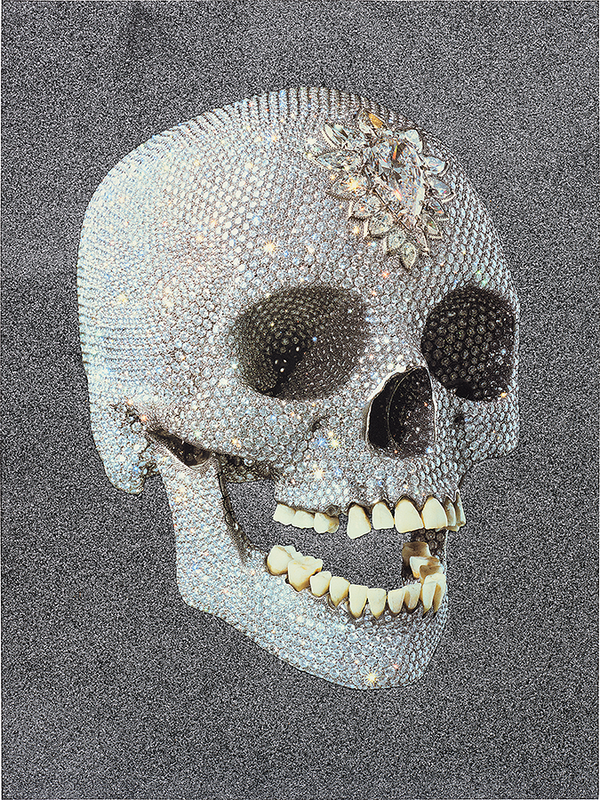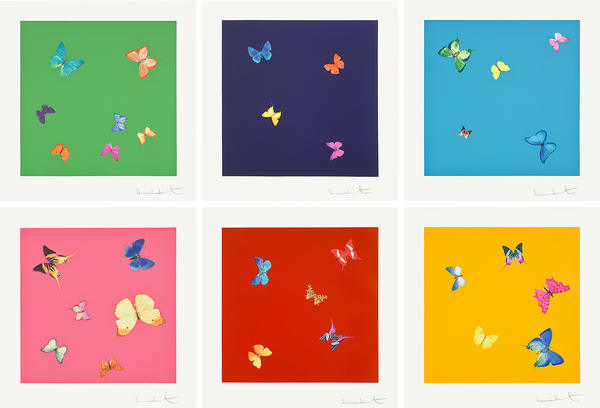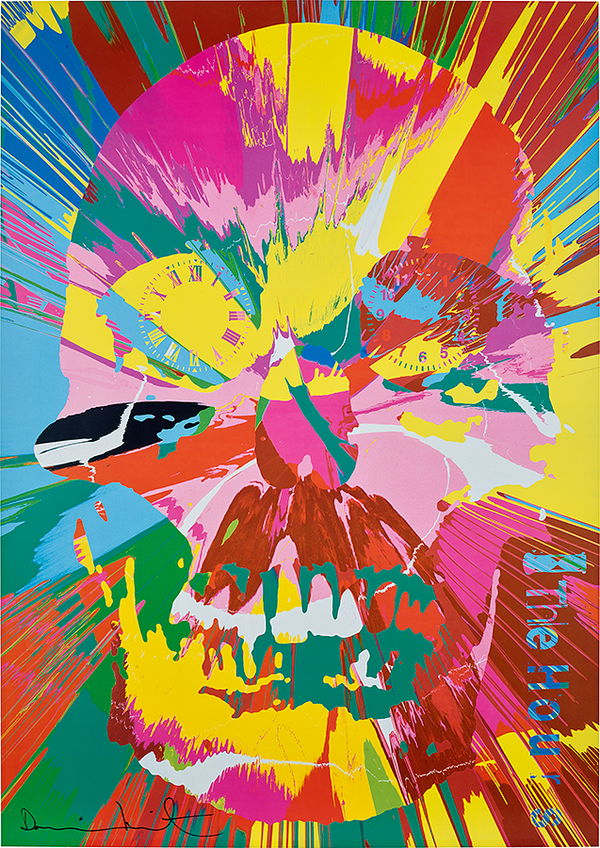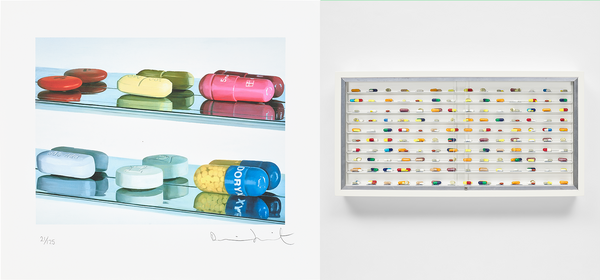Damien Hirst, For the Love of God, Laugh, 2007. Damien Hirst: Online Auction.
Damien Hirst’s exploration of reincarnation blends science and spirituality into the areas of life which ask art to fill in the gaps left by both, challenging viewers to confront their own mortality with striking imagery of decay and regeneration. From his infamous early work The Physical Impossibility of Death in the Mind of Someone Living, featuring a preserved shark, to his vibrant, kaleidoscopic prints and installations, Hirst's art serves as a meditation on our interconnectedness. By combining the ephemeral with the eternal, he invites viewers to reflect on the possibility of transformation beyond the physical realm, prompting questions about the phenomenon of life and its potential for rebirth in countless forms — particularly in print, as Hirst often produces multiples as physical extensions of his inquiries.
Butterfly effects
Damien Hirst, Love Poems, 2014. Damien Hirst: Online Auction.
Being beautiful isn’t all it’s cracked up to be. Consider the cruel fate of the butterfly: to be born grubby, unremarkable; to suffer through adolescence as a metaphor for emerging at the end of hardship like some sort of motivational poster, and finally, when the cage bursts, it’s nothing but dodging nets and pins and Vladimir Nabokov floundering about in knee-high socks.
In Love Poems, Hirst uses butterflies to evoke deeper emotional and philosophical reflections on love, loss, and the passage of time. The juxtaposition of the delicate butterflies against stark backgrounds creates a tension that highlights the fleeting moments of joy and beauty in life. We see here the transformative power of love, observing that even in death, there is the potential for rebirth and new beginnings, much like the lifecycle of a butterfly. This interplay between life and death underscores his broader thematic explorations of existence and the eternal cycle that binds all living things.
It'll make your head spin
Damien Hirst, Beautiful Hours Spin Painting 1, 2009. Damien Hirst: Online Auction.
Among Spotify’s more intrusive bits of data collection is just how many times a song is replayed and repeated, which is then packaged for users as the Repeat/Rewind playlist. Head down time in the editorial department often means listening to the same song for hours; in today’s case it’s coincidentally “Death or Glory” by The Clash. Made for the cover of British rock band The Hours' See the Light album, Spin Painting I is a quintessentially Hirstian connection come to life. He met the band through their mutual friend Joe Strummer, the co-founder of The Clash. Hirst and Strummer became friends after meeting at a festival in 1995, and the punk icon played a significant role in Hirst's life. After Strummer's tragic passing in 2002, Hirst remarked that it was the first time he truly felt his own mortality, which deepened his fascination with the theme.
The Spin Painting prints typify the artist’s iterative practice in an abstract and dynamic manner. These works embody a sense of chaotic energy and spontaneous creation, evoking the constant flux inherent in nature. Additionally, the vibrant colors and swirling patterns can be seen as representations of the beauty found in life's transitions. Just as butterflies emerge from their cocoons, these works celebrate transformation and the potential for renewal, with each edition becoming a record of this process, a moment captured in time that reflects the unpredictable elements of chance and control. Death or glory? Why not both?
Lived, laughed, loving it
Damien Hirst, For the Love of God, Laugh, 2007. Damien Hirst: Online Auction.
It’s refreshing to meet someone these days who hasn’t gotten veneers. Really, one could do worse than to wait out a reincarnation reload period in a catacomb this fabulous. There are certainly less glamorous ways to decompose, and diamonds, as they say to avoid copyright, last a very, very, very long time.
In this work, Hirst returns to the themes he has explored throughout his career: the fragility of life, the inevitability of death, and the quest for meaning. Rendered as a print, we are given a side view of the skull in mid-laugh at the memento mori, as if to say alright mate, we’re here, what now? The skull becomes a vehicle for how we honor our own lives and the legacies we leave behind, often in search of immortality. By adorning the skull with luxurious opulence, Hirst suggests that even in death, there is a potential for transformation — an assertion that beauty can emerge from the stark reality of mortality, and indeed carry on after its useful life. For anyone who’s ever had to think about how an urn would look with the rest of a room’s décor, the option to bejewel a skull seems no less absurd than trying to color-match a mantle.
They've got a pill for that now
Left: Damien Hirst, Six Pills, 2004. Right: Damien Hirst, Day in Day Out, 2003. Damien Hirst: Online Auction.
The most unequivocal good of modern medicine is its ability to turn death sentences into manageable conditions for living. Its most ambiguous facet is its capacity to pathologize just about anything else. Everyone in the pill commercial is skydiving and ballroom dancing and taking the boat to the sandbar with no symptoms of whatever it was they had. Fitter, happier, more productive; even OK Computer is old enough to feel its joints ache as it reaches for the glucosamine.
Hirst's use of pills as a motif explores the notion of reincarnation within our own lifetimes, reminding us of our continual attempts to manage our well-being and seek improvement. In works such as Six Pills, Hirst employs pharmaceuticals as symbols of both physical and existential renewal. We are capable of reinventing ourselves repeatedly — stability through stabilizers, suppression through suppressants — and it’s no surprise that a life without friction and pain is represented through smooth, colorful, and easy-to-swallow capsules. Hirst's exploration of the pharmaceutical industry also critiques society's reliance on quick fixes for deeper issues, suggesting that true transformation often requires more than mere consumption of medicine. In the cabinet these are prescriptions, necessary interventions; in a baggie they’re contraband. This interplay reinforces the idea that reincarnation is not just a spiritual concept, but a continuous journey of self-discovery and change in our everyday lives — one that can be self-guided or prescribed.
Recommended Reading
Specialist Picks: How Much is That Rhinoceros in the Window? >




